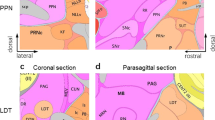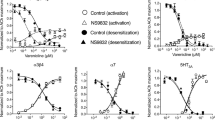Abstract
Nicotine addiction begins with high-affinity binding of nicotine to acetylcholine (ACh) receptors in the brain. The end result is over 4,000,000 smoking-related deaths annually worldwide and the largest source of preventable mortality in developed countries. Stress reduction, pleasure, improved cognition and other central nervous system effects are strongly associated with smoking. However, if nicotine activated ACh receptors found in muscle as potently as it does brain ACh receptors, smoking would cause intolerable and perhaps fatal muscle contractions. Despite extensive pharmacological, functional and structural studies of ACh receptors, the basis for the differential action of nicotine on brain compared with muscle ACh receptors has not been determined. Here we show that at the α4β2 brain receptors thought to underlie nicotine addiction, the high affinity for nicotine is the result of a strong cation–π interaction to a specific aromatic amino acid of the receptor, TrpB. In contrast, the low affinity for nicotine at the muscle-type ACh receptor is largely due to the fact that this key interaction is absent, even though the immediate binding site residues, including the key amino acid TrpB, are identical in the brain and muscle receptors. At the same time a hydrogen bond from nicotine to the backbone carbonyl of TrpB is enhanced in the neuronal receptor relative to the muscle type. A point mutation near TrpB that differentiates α4β2 and muscle-type receptors seems to influence the shape of the binding site, allowing nicotine to interact more strongly with TrpB in the neuronal receptor. ACh receptors are established therapeutic targets for Alzheimer’s disease, schizophrenia, Parkinson’s disease, smoking cessation, pain, attention-deficit hyperactivity disorder, epilepsy, autism and depression1. Along with solving a chemical mystery in nicotine addiction, our results provide guidance for efforts to develop drugs that target specific types of nicotinic receptors.
This is a preview of subscription content, access via your institution
Access options
Subscribe to this journal
Receive 51 print issues and online access
$199.00 per year
only $3.90 per issue
Buy this article
- Purchase on Springer Link
- Instant access to full article PDF
Prices may be subject to local taxes which are calculated during checkout





Similar content being viewed by others
References
Romanelli, M. N. et al. Central nicotinic receptors: structure, function, ligands, and therapeutic potential. ChemMedChem 2, 746–767 (2007)
Corringer, P. J., Le Novere, N. & Changeux, J. P. Nicotinic receptors at the amino acid level. Annu. Rev. Pharmacol. Toxicol. 40, 431–458 (2000)
Coe, J. W. et al. Varenicline: An α4β2 nicotinic receptor partial agonist for smoking cessation. J. Med. Chem. 48, 3474–3477 (2005)
Gotti, C., Zoli, M. & Clementi, F. Brain nicotinic acetylcholine receptors: native subtypes and their relevance. Trends Pharmacol. Sci. 27, 482–491 (2006)
Mansvelder, H. D., Keath, J. R. & McGehee, D. S. Synaptic mechanisms underlie nicotine-induced excitability of brain reward areas. Neuron 33, 905–919 (2002)
Nashmi, R. et al. Chronic nicotine cell specifically upregulates functional α4* nicotinic receptors: basis for both tolerance in midbrain and enhanced long-term potentiation in perforant path. J. Neurosci. 27, 8202–8218 (2007)
Tapper, A. R. et al. Nicotine activation of α4* receptors: sufficient for reward, tolerance, and sensitization. Science 306, 1029–1032 (2004)
Kuryatov, A., Luo, J., Cooper, J. & Lindstrom, J. Nicotine acts as a pharmacological chaperone to up-regulate human α4β2 acetylcholine receptors. Mol. Pharm. 68, 1839–1851 (2005)
Zhong, W. et al. From ab initio quantum mechanics to molecular neurobiology: A cation-π binding site in the nicotinic receptor. Proc. Natl Acad. Sci. USA 95, 12088–12093 (1998)
Brejc, K. et al. Crystal structure of an ACh-binding protein reveals the ligand-binding domain of nicotinic receptors. Nature 411, 269–276 (2001)
Sixma, T. K. & Smit, A. B. Acetylcholine binding protein (AChBP): a secreted glial protein that provides a high-resolution model for the extracellular domain of pentameric ligand-gated ion channels. Annu. Rev. Biophys. Biomol. Struct. 32, 311–334 (2003)
Dougherty, D. A. Cys-loop neuroreceptors: structure to the rescue? Chem. Rev. 108, 1642–1653 (2008)
Beene, D. L. et al. Cation-π interactions in ligand recognition by serotonergic (5–HT3A) and nicotinic acetylcholine receptors: The anomalous binding properties of nicotine. Biochemistry 41, 10262–10269 (2002)
Dougherty, D. A. Physical organic chemistry on the brain. J. Org. Chem. 73, 3667–3673 (2008)
Nowak, M. W. et al. In vivo incorporation of unnatural amino acids into ion channels in a Xenopus oocyte expression system. Methods Enzymol. 293, 504–529 (1998)
Fonck, C. et al. Novel seizure phenotype and sleep disruptions in knock-in mice with hypersensitive α4* nicotinic receptors. J. Neurosci. 25, 11396–11411 (2005)
Filatov, G. N. & White, M. M. The role of conserved leucines in the M2 domain of the acetylcholine receptor in channel gating. Mol. Pharmacol. 48, 379–384 (1995)
Labarca, C. et al. Channel gating governed symmetrically by conserved leucine residues in the M2 domain of nicotinic receptors. Nature 376, 514–516 (1995)
Kearney, P. et al. Dose-response relations for unnatural amino acids at the agonist binding site of the nicotinic acetylcholine receptor: Tests with novel side chains and with several agonists. Mol. Pharmacol. 50, 1401–1412 (1996)
Moroni, M., Zwart, R., Sher, E., Cassels, B. K. & Bermudez, I. α4β2 nicotinic receptors with high and low acetylcholine sensitivity: pharmacology, stoichiometry, and sensitivity to long-term exposure to nicotine. Mol. Pharmacol. 70, 755–768 (2006)
Nelson, M. E., Kuryatov, A., Choi, C. H., Zhou, Y. & Lindstrom, J. Alternate stoichiometries of α4β2 nicotinic acetylcholine receptors. Mol. Pharmacol. 63, 332–341 (2003)
Celie, P. H. et al. Nicotine and carbamylcholine binding to nicotinic acetylcholine receptors as studied in AChBP crystal structures. Neuron 41, 907–914 (2004)
Hansen, S. B. et al. Structures of aplysia AChBP complexes with nicotinic agonists and antagonists reveal distinctive binding interfaces and conformations. EMBO J. 24, 3635–3646 (2005)
Talley, T. T. et al. Spectroscopic analysis of benzylidene anabaseine complexes with acetylcholine binding proteins as models for ligand-nicotinic receptor interactions. Biochemistry 45, 8894–8902 (2006)
Cashin, A. L., Petersson, E. J., Lester, H. A. & Dougherty, D. A. Using physical chemistry to differentiate nicotinic from cholinergic agonists at the nicotinic acetylcholine receptor. J. Am. Chem. Soc. 127, 350–356 (2005)
Deechongkit, S. et al. Context-dependent contributions of backbone hydrogen bonding to β-sheet folding energetics. Nature 430, 101–105 (2004)
England, P. M., Zhang, Y., Dougherty, D. A. & Lester, H. A. Backbone mutations in transmembrane domains of a ligand-gated ion channel: implications for the mechanism of gating. Cell 96, 89–98 (1999)
Koh, J. T., Cornish, V. W. & Schultz, P. G. An experimental approach to evaluating the role of backbone interactions in proteins using unnatural amino acid mutagenesis. Biochemistry 36, 11314–11322 (1997)
Grutter, T. et al. An H-bond between two residues from different loops of the acetylcholine binding site contributes to the activation mechanism of nicotinic receptors. EMBO J. 22, 1990–2003 (2003)
Sine, S. M. et al. Mutation of the acetylcholine receptor α subunit causes a slow-channel myasthenic syndrome by enhancing agonist binding affinity. Neuron 15, 229–239 (1995)
McManus, O. B., Blatz, A. L. & Magleby, K. L. Sampling, log binning, fitting, and plotting durations of open-and-shut intervals from single channels and the effects of noise. Pflugers Archiv-Eur. J. Physiol. 410, 530–553 (1987)
Acknowledgements
We thank B. N. Cohen for advice on single-channel recording and analysis. This work was supported by the NIH (NS 34407; NS 11756) and the California Tobacco-Related Disease Research Program of the University of California, grant number 16RT-0160. J.A.P.S. was partially supported by an NRSA training grant.
Author information
Authors and Affiliations
Corresponding author
Supplementary information
Supplementary Information
This file contains Supplementary Figures 1-3 with Legends, Supplementary Table 1, a Supplementary Discussion and Supplementary References. (PDF 995 kb)
Rights and permissions
About this article
Cite this article
Xiu, X., Puskar, N., Shanata, J. et al. Nicotine binding to brain receptors requires a strong cation–π interaction. Nature 458, 534–537 (2009). https://doi.org/10.1038/nature07768
Received:
Accepted:
Published:
Issue Date:
DOI: https://doi.org/10.1038/nature07768
This article is cited by
-
Unexpectedly efficient ion desorption of graphene-based materials
Nature Communications (2022)
-
Concatemers to re-investigate the role of α5 in α4β2 nicotinic receptors
Cellular and Molecular Life Sciences (2021)
-
Gamma synuclein is a novel nicotine responsive protein in oral cancer malignancy
Cancer Cell International (2020)
-
Mechanism of biomolecular recognition of trimethyllysine by the fluorinated aromatic cage of KDM5A PHD3 finger
Communications Chemistry (2020)
-
Theoretical study on noncovalent interaction of molecular tweezers by Zn(II) salphen-azo-crown ether triads receptor
Journal of Molecular Modeling (2020)
Comments
By submitting a comment you agree to abide by our Terms and Community Guidelines. If you find something abusive or that does not comply with our terms or guidelines please flag it as inappropriate.



